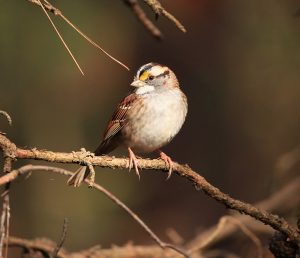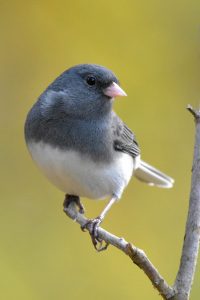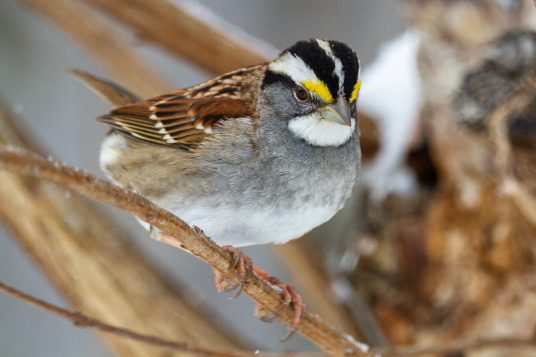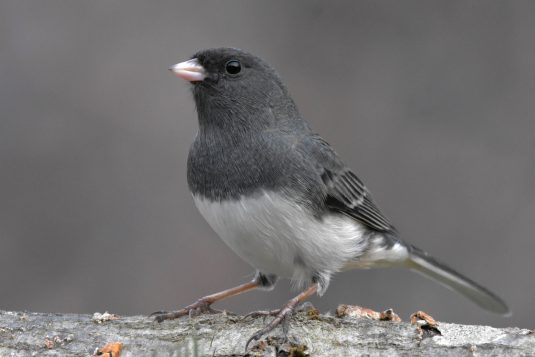Nature Matters: Two winter friends
By John L. Turner

Walking along the edge of an uneven row of withered goldenrods, adorned with countless fuzzy heads brimming with seeds, I noticed some bird movement in the lower branches of the shrubs interspersed among the flowers. Lots of movement in all directions as the small earth-toned birds flitted up and down, toward and away from me. I was in the presence of a flock of fourteen white-throated sparrows actively feeding on the ubiquitous goldenrod seed. Their presence was a nice welcome to my morning.
The white-throated sparrow is a most handsome bird, possessing, as its name makes clear, a distinctive white throat patch (its Latin name is Zonotrichia albicollis with albicollis meaning “white-necked”). Even more prominent in this species are the five bold longitudinal black and white head stripes (three white and two black) with a pretty splash of yellow just behind the bill in a place known as the lores on the two lateral white stripes.
There’s an interesting story about these light-colored head stripes that underscores how the natural world is much more complex than it may, at first, appear. These stripes come in two distinct colors: white and tan, so a sparrow may be a tan-striped white-throated sparrow or a white-striped white-throated sparrow. This color difference is genetically based, apparently due to a single chromosome part inverting while going through mitosis — remember genetics from high school biology class? In a case of mistaken identity John James Audubon thought white-striped individuals were male while tan-striped birds female, a reasonable assumption given the fact more colorful birds are typically male. You can see this mistake in his illustration of the species in his famous “Birds of America.”
Birds of the same species that display different plumages are referred to as “morphs” or “forms.” The Eastern Screech Owl is another local example of a bird species that exhibits morphs, having two colorful forms — grey and rufous birds. The Parasitic Jaeger, a gull-like bird occasionally seen in the ocean off the island’s south shore has three color morphs — light, intermediate, and dark.

And you might reasonably think that white-striped males would always select a white-striped female as a mate and the same with tan-striped individuals, but it’s actually just the opposite. White-striped males overwhelmingly prefer tan-striped females (and vice versa) while tan striped males select white-striped females (also vice versa), a concept ecologists fancily refer to as “negative assortative mating.” Researchers have determined the morphs behave differently with white-striped birds being more aggressive but with less adept parenting abilities than tan-striped birds. These two traits seem to balance out as the two morphs are about equally represented in the species overall.
White-throated sparrows don’t breed on Long Island (with very few noted records) but are common winter visitors and one of the more common species to visit bird feeding stations, often feeding on the millet and other grain that spills to the ground. If white-throated sparrows come to your feeders try to distinguish the two color morphs and note any difference in behaviors. As mentioned above, research suggests the white-striped forms are more aggressive and tend to dominate tan-striped individuals. Have you observed this?
As winter melds into spring you might hear the distinctive song of this sparrow. One of the bird’s colloquial names — Old Sam Peabody — comes from its song that seems like it’s saying that fella’s name with a few extra Peabody’s thrown in at the end. Others liken it to My Sweet Canada, Canada, Canada. I think the second description is a wee bit more accurate both because it sounds closer to the bird’s song and because the species breeds across a broad swath of forest in our country neighbor to the North.
Another common winter visitor to bird feeders is a sparrow that doesn’t much look like one, as it doesn’t have the earth-tone browns and tans typical of most sparrow species. It’s the Slate-colored or Dark-eyed Junco or as the famous New York naturalist John Burroughs called them “snowbirds” since they often appear in New York around the time of the season’s first snowfall.
A widespread breeder across North America (but not Long Island as it breeds further north) this species consists of 15 subspecies many of which look different, giving rise to distinctive names such as the white-winged, pink-sided, red-backed, and gray-headed juncos. Given their distinctive morphological differences, which is thought to have occurred a few thousand years ago, this species appears to be on its way to evolving into several other species. If we can hang around for a few thousand more years we might find out the answer.
The junco (it’s Latin name is hyemalis meaning “of the winter”) is a handsome bird with “our” subspecies being dark grey on top with white on the belly and under the tail. Females are tinged with brown on top. Both sexes have triangular pink bills, the color of bubble gum, which they use to capture insects, collect seeds and berries, and/or the food you put out in your feeders.

Speaking of feeders, according to Project FeederWatch, run by the Cornell University’s Project Laboratory of Ornithology, the Dark-eyed Junco is recorded at more feeders in North America than any other bird.
Another plumage trait all juncos share are outer tail feathers that range from partially to fully white. These bright white “banner marks” are examples of deflective coloration and are a feature commonplace in birds. It’s hypothesized their function is to confuse predators or deflect their attack to a non-lethal part of a bird’s body but this purpose has not been proven experimentally beyond a reasonable doubt so the purpose remains conjectural. The Eastern Meadowlark and American Robin are other examples of birds exhibiting banner marks.
Another interesting aspect of junco life is that not all birds overwinter in the same area. Generally male juncos, both adult and young, overwinter in more northern locales while females migrate further south. The reason for this seems to be the desire for male birds to be closer to prime breeding territories, the adults to reclaim them and younger males in an effort to quickly find an available territory. Females have no such worries and can benefit from more moderate climates to the south.
So, what at first appears to be two nice uncomplicated winter visitors visiting your feeding station actually reveal, like when the layers of an onion are peeled back, a reality with complexity and depth possessed by all living creatures that share our world.
A resident of Setauket, author John Turner is conservation chair of the Four Harbors Audubon Society, author of “Exploring the Other Island: A Seasonal Nature Guide to Long Island” and president of Alula Birding & Natural History Tours








